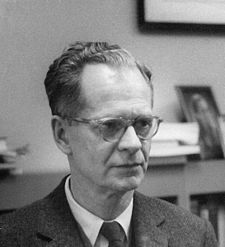Burrhus Frederic Skinner (1904 – 1990) was an American behaviorist, author, inventor, social philosopher, and poet. He was the Edgar Pierce Professor of Psychology at Harvard University from 1958 until his retirement in 1974.
Skinner invented the operant conditioning chamber, innovated his own philosophy of science called Radical behaviorism, and founded his own school of experimental research psychology—the experimental analysis of behavior. His analysis of human behavior culminated in his work Verbal Behavior, which has recently seen enormous increase in interest experimentally and in applied settings.Skinner discovered and advanced the rate of response as a dependent variable in psychological research. He invented the cumulative recorder to measure rate of responding as part of his highly influential work on schedules of reinforcement. In a June, 2002 survey, Skinner was listed as the most influential psychologist of the 20th century. He was a prolific author who published 21 books and 180 articles.
(2) Reinforcement (pigeon experiment)
See the U-tube attached bellow.
(cf) This video clip was extracted from http://www.youtube.com/watch?v=AepqpTtKbwo.
This clip is used here for the educational purpose.
(3) Influence on education
Skinner influenced education as well as psychology. He was quoted as saying "Teachers must learn how to teach ... they need only to be taught more effective ways of teaching." Skinner asserted that positive reinforcement is more effective at changing and establishing behavior than punishment, with obvious implications for the then widespread practice of rote learning and punitive discipline in education. Skinner also suggests that the main thing people learn from being punished is how to avoid punishment.
In The Technology of Teaching, Skinner has a chapter on why teachers fail (pages 93-113): Essentially he says that teachers have not been given an understanding of teaching and learning. Without the science underpinning teaching, teachers fall back on procedures that work poorly or not at all, such as..
- using aversive techniques. They produce escape and avoidance and undesirable emotional effects.
- relying on telling and explaining. "Unfortunately, a student does not learn simply when he is shown or told."
- failing to adapt learning tasks to the student's current level.
- failing to provide positive reinforcement frequently enough.
- Clearly specify the action or performance the student is to learn to do
- Break down the task into small achievable steps, going from simple to complex.
- Let the student perform each step, reinforcing correct actions
- Adjust so that the student is always successful until final the goal is reached
- transfer to intermittent reinforcement to maintain the student's performance
(3) Negative Criticsm
Chomsky also reviewed Skinner's Beyond Freedom and Dignity, using the same basic motives as his Verbal Behavior review. Among Chomsky's criticisms were that Skinner's laboratory work could not be extended to humans, that when it was extended to humans it represented 'scientistic' behavior attempting to emulate science but which was not scientific, that Skinner was not a scientist because he rejected the hypothetico-deductive model of theory testing, that Skinner had no science of behavior, and that Skinner's works were highly conducive to justifying or advancing totalitarianism. The fields of Relational Frame Theory and ACT Therapy are currently attempting to deal with most of these suggestions.
**This information source is from 'Wikipedia'.

No comments:
Post a Comment